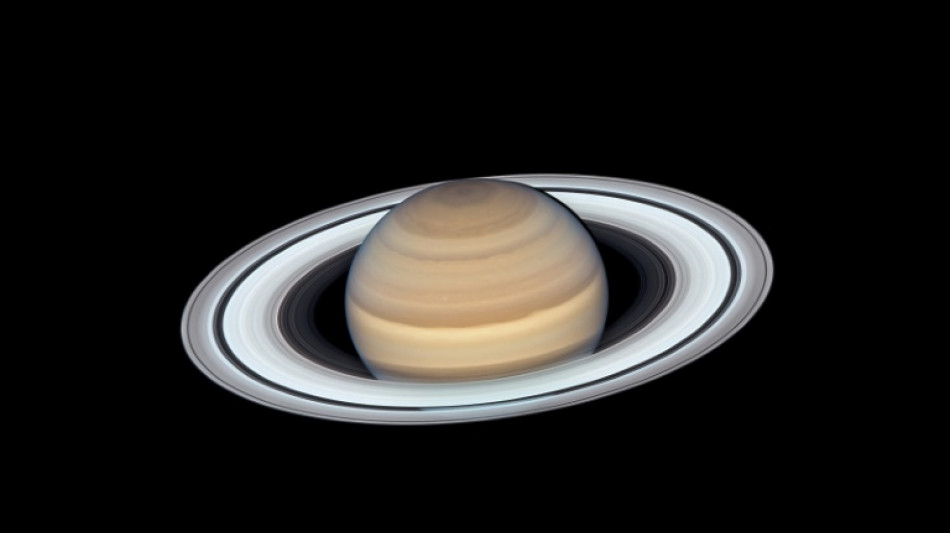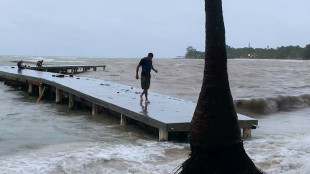
-
 Primary schools empty as smog persists in Indian capital
Primary schools empty as smog persists in Indian capital
-
Palestinians turn to local soda in boycott of Israel-linked goods

-
 Typhoon Man-yi bears down on Philippines still reeling from Usagi
Typhoon Man-yi bears down on Philippines still reeling from Usagi
-
UK growth slows in third quarter, dealing blow to Labour government

-
 Chris Wood hits quickfire double in NZ World Cup qualifying romp
Chris Wood hits quickfire double in NZ World Cup qualifying romp
-
Markets struggle at end of tough week

-
 China tests building Moon base with lunar soil bricks
China tests building Moon base with lunar soil bricks
-
Film's 'search for Palestine' takes centre stage at Cairo festival

-
 Oil execs work COP29 as NGOs slam lobbyist presence
Oil execs work COP29 as NGOs slam lobbyist presence
-
Gore says climate progress 'won't slow much' because of Trump

-
 'Megaquake' warning hits Japan's growth
'Megaquake' warning hits Japan's growth
-
Stiff business: Berlin startup will freeze your corpse for monthly fee

-
 Wars, looming Trump reign set to dominate G20 summit
Wars, looming Trump reign set to dominate G20 summit
-
Xi, Biden attend Asia-Pacific summit, prepare to meet

-
 Kyrgios to make competitive return at Brisbane next month after injuries
Kyrgios to make competitive return at Brisbane next month after injuries
-
Dominican Juan Luis Guerra triumphs at 25th annual Latin Grammys

-
 Landslide win for Sri Lanka president's leftist coalition in snap polls
Landslide win for Sri Lanka president's leftist coalition in snap polls
-
Australian World Cup penalty hero Vine takes mental health break

-
 As Philippines picks up from Usagi, a fresh storm bears down
As Philippines picks up from Usagi, a fresh storm bears down
-
Tropical Storm Sara pounds Honduras with heavy rain

-
 Pepi gives Pochettino win for USA in Jamaica
Pepi gives Pochettino win for USA in Jamaica
-
'Hell to heaven' as China reignite World Cup hopes with late winner

-
 Rebel attacks keep Indian-run Kashmir on the boil
Rebel attacks keep Indian-run Kashmir on the boil
-
New Zealand challenge 'immense but fantastic' for France

-
 Under pressure England boss Borthwick in Springboks' spotlight
Under pressure England boss Borthwick in Springboks' spotlight
-
All Blacks plan to nullify 'freakish' Dupont, says Lienert-Brown

-
 TikTok makes AI driven ad tool available globally
TikTok makes AI driven ad tool available globally
-
Japan growth slows as new PM readies stimulus

-
 China retail sales pick up speed, beat forecasts in October
China retail sales pick up speed, beat forecasts in October
-
Asian markets fluctuate at end of tough week

-
 Gay, trans people voicing -- and sometimes screaming -- Trump concerns
Gay, trans people voicing -- and sometimes screaming -- Trump concerns
-
Argentina fall in Paraguay, Brazil held in Venezuela

-
 N. Korean leader orders 'mass production' of attack drones
N. Korean leader orders 'mass production' of attack drones
-
Pakistan's policies hazy as it fights smog

-
 Nature pays price for war in Israel's north
Nature pays price for war in Israel's north
-
New Zealand's prolific Williamson back for England Test series

-
 Mexico City youth grapple with growing housing crisis
Mexico City youth grapple with growing housing crisis
-
After Trump's victory, US election falsehoods shift left

-
 Cracks deepen in Canada's pro-immigration 'consensus'
Cracks deepen in Canada's pro-immigration 'consensus'
-
Xi inaugurates South America's first Chinese-funded port in Peru

-
 Tyson slaps Paul in final face-off before Netflix bout
Tyson slaps Paul in final face-off before Netflix bout
-
England wrap-up T20 series win over West Indies

-
 Stewards intervene to stop Israel, France football fans clash at Paris match
Stewards intervene to stop Israel, France football fans clash at Paris match
-
Special counsel hits pause on Trump documents case

-
 Japan's Princess Mikasa, great aunt to emperor, dies aged 101
Japan's Princess Mikasa, great aunt to emperor, dies aged 101
-
Cricket at 2028 Olympics could be held outside Los Angeles

-
 Trump names vaccine skeptic RFK Jr. to head health dept
Trump names vaccine skeptic RFK Jr. to head health dept
-
Ye claims 'Jews' controlling Kardashian clan: lawsuit

-
 Japan into BJK Cup quarter-finals as Slovakia stun USA
Japan into BJK Cup quarter-finals as Slovakia stun USA
-
Sri Lanka president's party headed for landslide: early results

| RBGPF | 100% | 61.84 | $ | |
| RYCEF | -4.71% | 6.79 | $ | |
| NGG | 0.4% | 62.37 | $ | |
| GSK | -2.09% | 34.39 | $ | |
| CMSD | -0.02% | 24.725 | $ | |
| CMSC | -0.24% | 24.55 | $ | |
| SCS | -0.75% | 13.27 | $ | |
| RIO | -0.31% | 60.43 | $ | |
| RELX | -0.37% | 45.95 | $ | |
| BCC | -1.57% | 140.35 | $ | |
| BTI | 0.2% | 35.49 | $ | |
| JRI | -0.23% | 13.21 | $ | |
| VOD | -0.81% | 8.68 | $ | |
| BCE | -1.38% | 26.84 | $ | |
| AZN | -0.38% | 65.04 | $ | |
| BP | 1.65% | 29.05 | $ |

Long lost moon could have been responsible for Saturn's rings
Discovered by Galileo 400 years ago, the rings of Saturn are about the most striking thing astronomers with small telescopes can spot in our solar system.
But even today, experts cannot agree on how or when they formed.
A new study published Thursday in the prestigious journal Science sets out to provide a convincing answer.
Between 100-200 million years ago, an icy moon they named Chrysalis broke up after getting a little too close to the gas giant, they conclude.
While most of it made impact with Saturn, its remaining fragments broke into small icy chunks that form the planet's signature rings.
"It's nice to find a plausible explanation," Jack Wisdom, professor of planetary sciences at MIT and lead author of the new study, told AFP.
Saturn, the sixth planet from the Sun, was formed four and a half billion years ago, at the beginning of the solar system.
But a few decades ago, scientists suggested that Saturn's rings appeared much later: only about 100 million years ago.
The hypothesis was reinforced by observations made by the Cassini probe, which orbited Saturn from 2004 to 2017.
"But because no one could think of a way to make the rings 100 million years ago, some people have been questioning the reasoning that led to that deduction," said Wisdom.
By constructing complex mathematical models, Wisdom and colleagues found an explanation that both justified the timeline, and allowed them to better understand another characteristic of the planet, its tilt.
Saturn has a 26.7 degree tilt. Being a gas giant, it would have been expected that the process of accumulating matter that led to its formation would have prevented tilt.
- Gravitational interactions -
Scientists recently discovered that Titan, the largest of Saturn's 83 moons, is migrating away from the planet, at a rate of 11 centimeters a year.
This changes the rate at which Saturn's axis of tilt loops around the vertical -- the technical term is "precession." Think of a spinning top drawing circles.
Around a billion years ago, this wobble frequency came into sync with Neptune's wobbly orbit, creating a powerful gravitational interaction called "resonance."
In order to maintain this lock, as Titan kept moving out, Saturn had to tilt, scientists argued.
But that explanation hinged on knowing how mass was distributed in the planet's interior, since the tilt would have behaved differently if it were concentrated more at its surface or the core.
In the new study, Wisdom and colleagues modeled the planet's interior using gravitational data gathered by Cassini during its close approach "Grand Finale," its last act before plunging into Saturn's depths.
The model they generated found Saturn is now slightly out of sync with Neptune, which necessitated a new explanation -- an event powerful enough to cause the drastic disruption.
Working through the mathematics, they found a lost moon fit the bill.
"It's pulled apart into a bunch of pieces and those pieces subsequently get pulled apart even more, and gradually rolls into the rings."
The missing Moon was baptized Chrysalis by MIT's Wisdom, likening the emergence of Saturn's rings to a butterfly emerging from a cocoon.
The team thinks Chrysalis was a bit smaller than our own Moon, and about the size of another Saturn satellite, Iapetus, which is made entirely of water ice.
"So it's plausible to hypothesize that Chrysalis is also made of water ice, and that's what it needs to make the rings, because the rings are almost pure water.
Asked whether he felt the mystery of Saturn's rings stood solved, Wisdom replied, soberly, "We've made a good contribution."
The Saturn satellite system still holds "a variety of mysteries," he added.
W.Morales--AT



